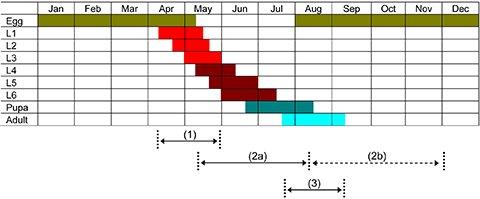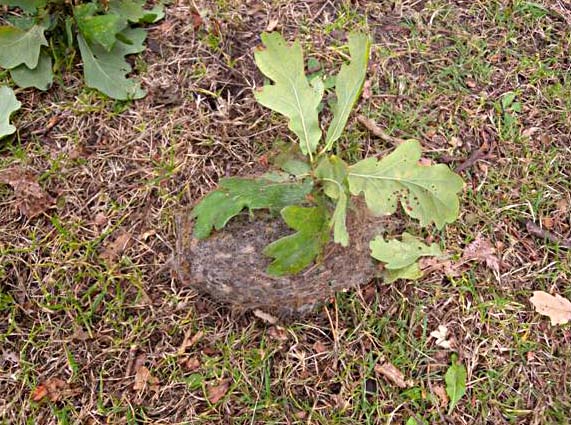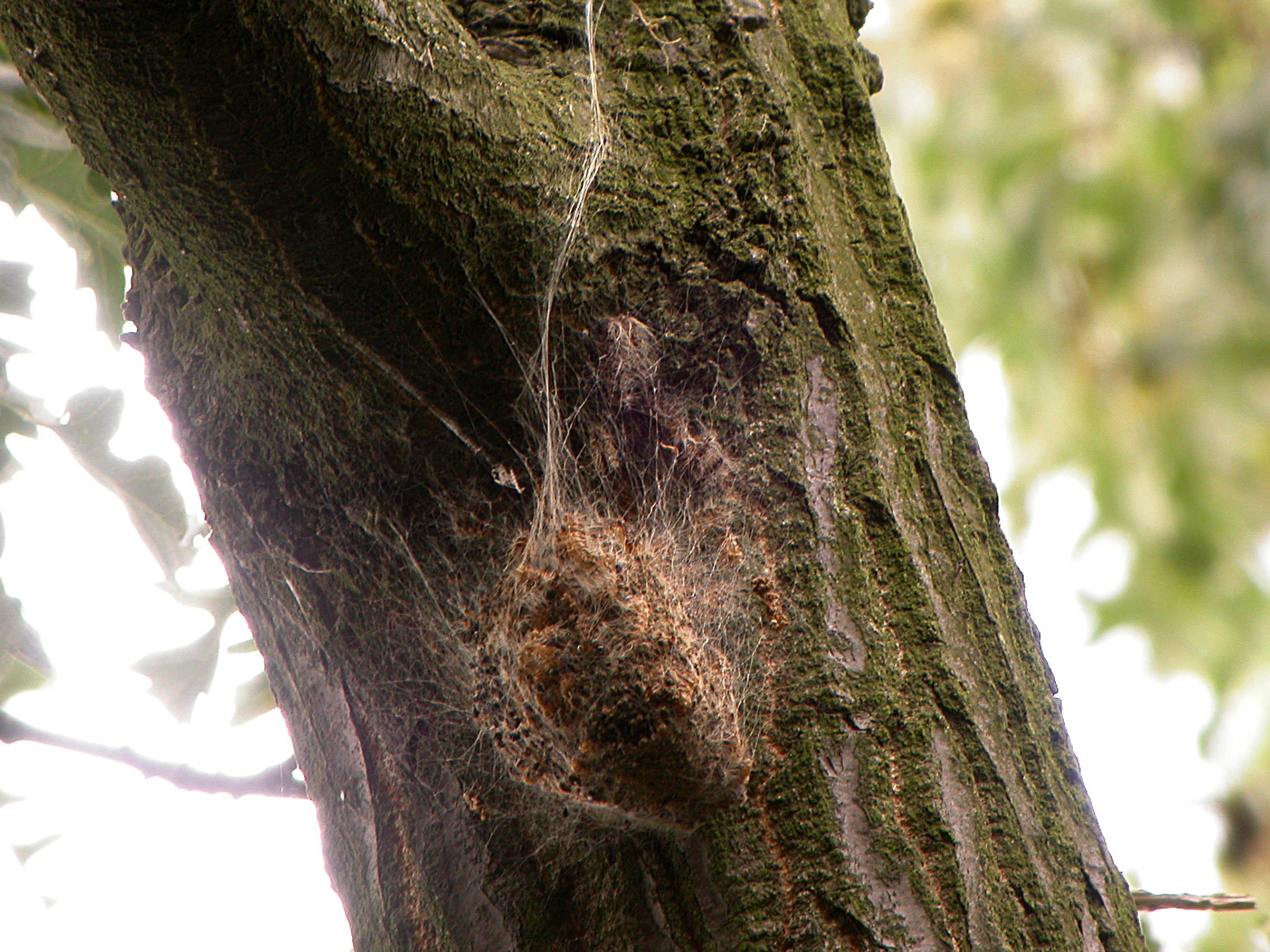Surveys for oak processionary moth (OPM) can be carried out at any time of the year by anyone with reasonable eyesight. Spring and winter are particularly useful times.
The number and the height of the trees can influence the time of year when surveys are carried out, the number of times each tree is surveyed, and the life stages being looked for.
Where there are only one or two oak trees on a site, such as a garden, it is worth checking for symptoms fairly frequently, from the ground, from several angles, and from upstairs windows. Binoculars are a useful aid.
OPM caterpillars, or larvae, can be present in all parts of the tree – on the trunk, branches and leaves, and also on the ground.
The table below sets out the life cycle of OPM. Note that the timings of the various growth stages are approximate, reflecting seasonal and local factors. In some years, especially in a warm spring, the L1 stage might appear as early as late March, and L4 by the first week of May.

Look for egg masses during the winter months. However, these are so small (2-3 cm long) that they are often difficult to spot. It might be impracticable to look for them on large oak trees or where trees are growing in large numbers, but it is worth doing on young, small oak trees where close inspection is practicable.
Surveying for spent, or used, nests can be carried out at any time, but they can be easier to see in winter when there are no leaves on the trees. Also check the ground under oak trees for old nests which have fallen out, as in the picture below.

Finding egg masses or old nests will provide early warning of the likely presence of caterpillars the following spring, and will help you and the Forestry Commission to plan spray treatment. Any egg masses found can be marked for regular inspection from late March onwards, and used as indicators of egg hatch and appearance of the first-stage caterpillars.
Early-stage caterpillars are the primary targets for bio-pesticide application, the timing of which is critical. This is because the preferred treatment product is less effective against older, larger caterpillars.
Surveying for young OPM caterpillars must be done in the spring, from late March to May, between the caterpillars’ emergence from the eggs and the time they start building their nests. The caterpillars are only about 2 mm long when they emerge, and tend to remain high in the trees until they are older and larger. They are still only about a centimetre (0.4 inches) long when they reach their third developmental stage, or instar, known as L3, after which they become tolerant of the preferred treatment.
The most effective method of controlling OPM is to apply bio-pesticide against the younger, early-stage (L1 to L3) caterpillars, so the earlier they are spotted and treated, the greater the chances of effective control.
Spraying must be done in most cases if the trees are in the Buffer Zone or Area free from the pest. If the affected trees are in the Established Area it is for the trees’ owners or managers to decide whether to treat them. However, we strongly encourage it to protect the health of the trees, people and animals.
The product used to treat the first three developmental stages, or instars, is the biological and growth-regulating bio-pesticide Bacillus thuringiensis var. kurstaki (BT). This has a low overall environmental impact and is sprayed on to the trees. As a rule of thumb, this should be used before the caterpillars exceed 1 cm long, because it is less effective against larger, older caterpillars.
See Section 6 – Chemical control of larvae.
This should be done in late spring and early summer, when the caterpillars are active and build their silken nests and trails. OPM does not build nests among the leaves, so when looking for nests, concentrate on the branches and trunks at all heights.
Check the ground under the oak trees as well for nests which have been dislodged and fallen to the ground. Almost white when new, the nests and trails soon become discoloured, as in the picture below, to a dirty brown or grey, and are harder to see as a result.

Picture: Ralph Parks, Forestry Commission
Nests can be in a variety of shapes and sizes, from hemispheres (half a ball) a few centimetres wide to blanket-like forms stretching several feet up a trunk. They can sag or collapse to resemble a bag clinging to the trunk or branch.
The older caterpillars spin bigger silken nests and spend more time in them during the day as they grow larger, and the nests protect them from treatment products. Therefore the main method of control for the 4th, 5th and 6th growth stages (L4, L5 and L6), and the pupal stage which follows L6, is to remove them and their nests. This can be done either by using specialised vacuum equipment, or by hand.
Both of these techniques should only be carried out by properly trained and equipped professional operators.
By this stage the nests have become tougher and contain cast skins and shed hairs. Removing nests immediately after they are discovered will reduce further damage to trees, and minimise the health risks posed by the irritating hairs which become dislodged in the nests. However, there is no guarantee that all the caterpillars which use the nests are inside the nests at the time – some might still be feeding elsewhere on the tree.
It can therefore be worth delaying nest removal until the caterpillars have moulted into pupae and are inside the nests 24 hours a day. This increases the chances of destroying all the caterpillars and pupae, preventing them from emerging as adult moths to mate and breed another generation.
Large, old nests need to be removed with considerable care to reduce the risk of exposure of people and animals to the hairs. These are inevitably shed in and on the nests, especially from the cast skins adhering to the nests.
Removing caterpillars and nests, by vacuum equipment or by hand, can be very effective in reducing OPM populations. However, this action alone is unlikely to lead to eradication, because it might not be possible to find and destroy every last caterpillar and pupa. It is therefore best used as a follow-up supplement to insecticide or bio-pesticide treatment.
See Section 7 – Manual removal of nests and larvae
Adult OPM, the moth stage of the life cycle, emerge and fly from about the middle of July to early September. Deployment of pheromone traps to catch male moths around the periphery of the known distribution areas during these weeks can help to provide an indication of changes in the pest’s distribution.
See Section 9 – Pheromone trapping for more-detailed guidance.
There are naturally occurring parasitoids that predate OPM. This includes a species of tachinid flies, Carcelia iliaca (C. iliaca) that is known to be present within the UK. See the Field identification guide for Carcelia iliaca for information about this OPM parasitoid.
If you do find OPM or their nests in your trees, regardless of which zone they are in, you must report it to us to enable us to monitor any changes in the pest’s distribution.
Please report it by using our TreeAlert on-line pest reporting tool (preferred). Note that you will need to upload a clear, well lit photograph to TreeAlert, but do not risk contact with the hairs to get it.
We and the Forestry Commission prefer reports via TreeAlert, but if you cannot use it, instructions for reporting sightings by email or telephone are given on our main OPM page.
Reports of sightings of OPM caterpillars or nests can be made at any time of year.